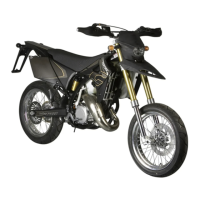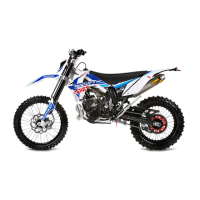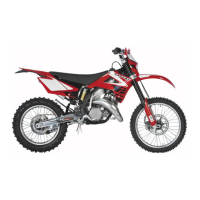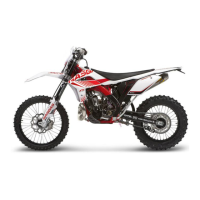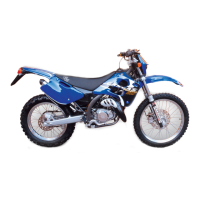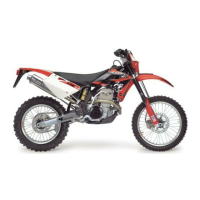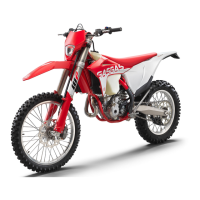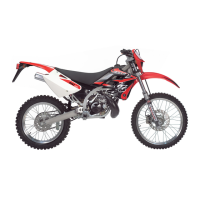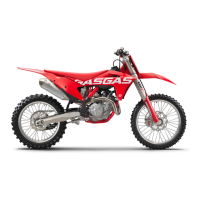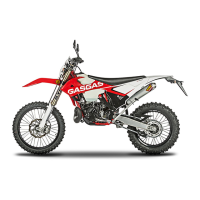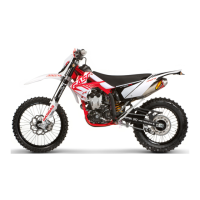Why aren't the headlight and parking light working on my GAS GAS Motorcycle?
- MMichelle PetersonSep 9, 2025
If the headlight and parking light are not functioning on your GAS GAS Motorcycle, it is likely due to a blown fuse 6. Replace the fuse.
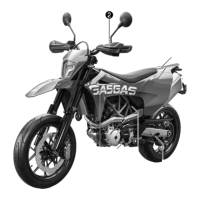
Why aren't the headlight and parking light working on my GAS GAS Motorcycle?
If the headlight and parking light are not functioning on your GAS GAS Motorcycle, it is likely due to a blown fuse 6. Replace the fuse.
Why are the turn signal, brake light, and horn not working on my GAS GAS SM 700 2023?
If the turn signal, brake light, and horn are not functioning on your GAS GAS Motorcycle, it is likely due to a blown fuse 5. Replace the fuse.
Why is the combination instrument display blank on my GAS GAS SM 700 2023 Motorcycle?
If the combination instrument shows nothing in the display on your GAS GAS Motorcycle, it could be due to a blown fuse 1 or 2. Replace the fuses.
| Engine Type | Single cylinder, 4-stroke |
|---|---|
| Bore x Stroke | 105 mm x 80 mm |
| Fuel System | Electronic Fuel Injection |
| Cooling System | Liquid-cooled |
| Transmission | 6-speed |
| Clutch | Wet multi-disc |
| Front Brake | Single disc, 320 mm |
| Rear Brake | Single disc, 240 mm |
| ABS | Yes |
| Seat Height | 890 mm |
| Power | 55 kW (74 hp) @ 8, 000 rpm |
| Frame | Steel trellis frame |
| Rear Suspension | WP APEX |
Explanation of the various symbols used to convey information in the manual.
Explanation of typographical formats like proprietary names and underlined terms.
Defines the proper use of the motorcycle and warns against misuse.
Details the different levels of risk and their associated symbols for safety.
Prohibition and consequences of tampering with noise control systems.
Essential safety instructions for operating the vehicle correctly and safely.
Importance of wearing appropriate protective gear for rider safety.
Guidelines for performing work on the motorcycle, including conditions.
Emphasis on reading the manual for operation, handling, and service.
Information regarding warranty coverage and conditions for service.
Importance of proper service for optimal operation and longevity.
Illustration and labeling of key components on the front left side.
Illustration and labeling of key components on the rear right side.
Location and importance of the VIN for identification.
Details on where to find the engine number for service and registration.
Operation of clutch lever, hand brake, throttle grip, and horn button.
Functionality of light, turn signal, emergency off, and start buttons.
Details on the combination switch for riding modes and the ABS button.
Ignition lock states and visual indicators on the dashboard.
Controls for seat, passenger foot pegs, and shift lever.
Correct usage of the foot brake lever and side stand.
Procedure for opening the fuel tank filler cap safely.
Detailed explanation of the combination instrument's displays and settings.
Essential safety and operational advice before riding the motorcycle for the first time.
Guidelines for breaking in the engine to ensure longevity and performance.
Recommendations for safely loading the motorcycle with luggage.
Mandatory checks and maintenance steps before each trip for roadworthiness.
Procedure and safety precautions for starting the motorcycle's engine.
Steps for smoothly starting the motorcycle from a standstill.
Techniques for shifting gears, riding, and handling the vehicle.
Explanation of the quickshifter feature for clutchless gear changes.
How to adjust and use the traction control system for enhanced grip.
Proper braking techniques, ABS usage, and safety warnings.
Safe methods for stopping the motorcycle and parking it securely.
Proper procedures and precautions for towing the motorcycle.
Instructions and safety warnings for refueling the fuel tank.
Notes on service work ordering and country-specific intervals.
Table outlining required maintenance tasks based on time and mileage intervals.
Introduction to chassis tuning options for suspension components.
Procedure for adjusting the compression damping on the front fork.
Procedure for adjusting the rebound damping on the front fork.
Explanation of high-speed and low-speed compression damping.
Procedure for adjusting the low-speed compression damping of the shock absorber.
Procedure for adjusting the rebound damping of the shock absorber.
Instructions for safely lifting the motorcycle using a lift stand.
Procedure for safely removing the motorcycle after it has been lifted.
Steps for cleaning fork dust boots to maintain fork seal integrity.
Procedure for removing the fork protector for maintenance or replacement.
Process for bleeding air from the front fork suspension.
Instructions for safely removing the motorcycle seat.
Procedure for correctly installing the motorcycle seat.
Steps to access and remove the onboard tool kit.
Procedure for properly storing the tool kit after use.
Instructions for removing the motorcycle's side fairing panel.
Procedure for correctly installing the motorcycle's side fairing panel.
Steps for safely removing the front fender.
Procedure for correctly mounting the front fender.
Instructions for accessing and removing the air filter element.
Procedure for correctly installing the air filter and its housing.
Procedure for inspecting the drive chain for excessive dirt or debris.
Detailed steps for cleaning the motorcycle's drive chain.
Method for checking the drive chain tension and its importance.
Procedure for adjusting the drive chain tension to the correct specification.
Inspection of the drive chain, sprockets, and chain guide for wear.
Procedure for adjusting the chain guide's position based on chain length.
Inspection of handlebar grips for damage, wear, and looseness.
Method for adjusting the clutch lever to rider preference.
Procedure for checking and maintaining the hydraulic clutch fluid level.
Explanation of ABS function, modes, and safety considerations.
Method for adjusting the hand brake lever to rider preference.
Procedure for inspecting brake discs for wear and damage.
Procedure for checking and maintaining the front brake fluid level.
Instructions for refilling the front brake fluid reservoir.
Procedure for ensuring front brake linings are correctly secured.
Method for checking the free play of the foot brake lever.
Procedure for adjusting the foot brake lever's basic position.
Procedure for checking and maintaining the rear brake fluid level.
Instructions for refilling the rear brake fluid reservoir.
Procedure for ensuring rear brake linings are correctly secured.
Step-by-step instructions for removing the front wheel.
Step-by-step instructions for installing the front wheel.
Step-by-step instructions for removing the rear wheel.
Step-by-step instructions for installing the rear wheel.
Procedure for inspecting damping rubber pieces for wear and damage.
Inspection of tires for cuts, damage, and tread depth.
Correct tire pressure settings for solo and passenger riding.
Guidelines and warnings for using tire repair spray in emergencies.
Step-by-step instructions for safely removing the 12-V battery.
Procedure for correctly installing the 12-V battery.
Instructions and safety precautions for charging the 12-V battery.
Procedure for locating and replacing the main fuse.
Instructions for locating and replacing fuses related to the ABS system.
Procedure for locating and replacing fuses for various electrical components.
Steps for safely removing the headlight mask assembly.
Procedure for correctly installing the headlight mask assembly.
Instructions for replacing the main headlight bulb.
Procedure for replacing the small position light bulb.
Method for verifying and adjusting the headlight beam alignment.
Procedure for adjusting the headlight beam's vertical range.
Explanation of the motorcycle's cooling system components and function.
Procedure for checking coolant level and antifreeze protection.
Detailed steps for checking coolant levels in the reservoir and radiator.
Instructions for safely draining the coolant from the system.
Procedure for refilling and bleeding air from the cooling system.
Step-by-step guide for replacing the motorcycle's coolant.
How to select different riding modes (Street, Sport) via the MAP button.
Procedure for activating and deactivating the traction control system.
Verifying the correct distance between boot and shift lever.
Procedure for adjusting the shift lever's position for optimal ergonomics.
Procedure for checking the engine oil level when the engine is warm.
Instructions for draining oil, changing the oil filter, and cleaning screens.
Procedure for adding engine oil to the correct level.
Safe procedures for washing and cleaning the motorcycle.
Precautions and maintenance steps for using the motorcycle in winter conditions.
Guidelines for storing the motorcycle for extended periods.
Steps to take to ready the motorcycle after a storage period.
Identifies common faults, their possible causes, and recommended actions.
Detailed technical data for the motorcycle's engine.
Specifications for torque values for engine-related screws and bolts.
Specifications for fluid capacities like engine oil and coolant.
Details on frame, suspension, brakes, and wheel dimensions.
Data on battery, fuses, lights, and other electrical components.
Details on fork type, damping, spring rate, and oil.
Details on shock absorber type, damping, and fitted length.
Specifications for torque values for chassis-related screws and bolts.
Information on brake fluid standards, properties, and recommended suppliers.
Details on coolant requirements, antifreeze protection, and suppliers.
Recommended chain cleaner and its application.
Recommended fuel additive for storage and performance.
Explanation of the JASO T903 MA2 standard for motorcycle engine oils.
Explanation of the SAE standard for classifying oil viscosity.
Definition of ABS (Anti-lock Braking System) and its safety function.
Definition of MTC (Motorcycle Traction Control) and its auxiliary function.
Definition of OBD (On-board Diagnosis) system and its function.
Definition of Quickshifter + function for gear shifting.
Explanation of the abbreviation 'Art. no.' for article number.
Explanation of the abbreviation 'ca.' for circa (approximately).
Explanation of red symbols indicating error conditions requiring intervention.
Explanation of yellow/orange symbols indicating prompt intervention or driving aids.
Explanation of green/blue symbols providing informational feedback.

